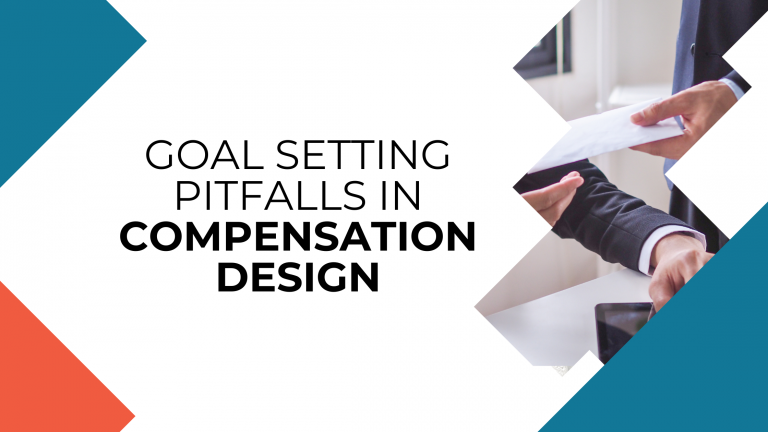Sales compensation thrives on well-defined goals. Despite this, many companies falter here, confusing short-term targets with strategic objectives, among other mistakes. As markets shift, compensation plans grounded in clear goals remain resilient and aligned with the broader vision. When a strategy lacks clear goals, however, it leads to frequently changing plans, distrust, and instability. Moreover, as top performers step up to the leadership void, the business invariably ends up being pulled in different directions. Let’s explore goal setting in compensation design by diving into the most common pitfalls that businesses make. By keeping an eye out for what not to do, you’ll be able to anchor your compensation strategy for long-term success.
Before we dive in, a quick review of what a goal is when it comes to compensation design:
What is a Strategic Goal in Compensation Design?
In the context of compensation design, a goal refers to a well-defined, strategic objective that is intended to guide the development and implementation of a compensation plan. It’s not merely a sales target or a financial milestone but rather a broader, holistic ambition that aligns the rewards and incentives structure with the overall business strategy and organizational values. A goal could encompass various facets like enhancing employee performance, driving particular behaviors, fostering a specific organizational culture, or steering the team towards achieving long-term business objectives. It should be clear, measurable, aligned with business strategies, and communicated effectively to all relevant stakeholders to ensure that the compensation plan supports and drives the desired outcomes.
Common Goal Setting Pitfalls
Navigating the world of goal setting in the context of compensation design presents unique challenges. Every reasonable compensation plan designer aims at efficacy and alignment. Despite this, we see common pitfalls that often derail their efforts. From conflating strategic goals with sales targets to succumbing to short-term fiscal pressures, it’s important to understand where others go wrong so that you can go right. Let’s explore the frequent missteps organizations unknowingly take, and the unintended repercussions that emanate from them.
1. Confusing Targets with Strategy
As we’ve alluded to already, this is one of the biggest and most common mistakes that businesses make. “Increase sales by 15%” may be a great target, but it says nothing of the path employees should take to get there. The bottom line is this: If your goal is informed by fiscal objectives, it’s not a strategic goal.
2. The One-Size-Fits-All Approach
We’ve seen an objective defined as “add 60 new clients to our books.” However, this does not take into account the varying roles, experiences, and challenges of individuals or teams in the business. Without considering different territories, market conditions, individual capacities, and all the other factors at play, this, too, lacks leadership.
3. Lack of Clarity
Establishing goals that are vague, non-specific, and do not provide a clear path or criteria for measuring achievement is another major pitfall. “Improve customer service” may indeed be the right trajectory for a company. However, without measurable criteria or more specification into what improvement looks like, your team will be optimizing for very different qualities.
4. Ignoring the External Environment
Some businesses make the mistake of forming goals without considering market dynamics, customer behavior, and external risks that affect performance and achievability. This runs the risk of hurting morale and creating a disconnect with management. The most egregious example we’ve seen is a business maintaining aggressive expansion goals without adapting to the economic downturn of the times.
5. Failing to Align with Broader Objectives
This is the mistake of designing goals that are not in harmony with the overarching mission, vision, and strategic objectives of the organization. An example would be when a company sets a target of selling X units of a particular product or service but fails to consider the wider objective of moving into premium markets. As a result, the sales team may achieve their targets, but the broader business misses theirs.
6. Overemphasis on Financial Metrics
This mistake occurs when a business focuses too much on revenue, profit, or other financial metrics, neglecting non-financial aspects like customer satisfaction, employee development, or market share. Examples of this are as self-evident as they are abundant. One in particular that we see frequently is businesses rewarding cost-cutting without properly considering the impact on service quality or customer satisfaction. The longer-term ramifications include everything from increased turnover to poor client retention.
7. Overcomplexity
This misstep occurs when businesses create excessively complex and multi-faceted goals that are hard to understand, communicate, and manage. The most common example of this is when “a goal” is actually made up of multiple different goals, making it difficult for employees to prioritize effectively.
8. Static Nature
Some businesses fail to reassess and modify goals in response to changing internal and external environments, keeping them rigid and potentially obsolete. A good example of this would be a store continuing their trajectory of opening five new brick and mortar locations, despite the surge of online sales and an apparent shift in customer buying behavior.
9. Neglecting Stakeholder Involvement
Not involving the input and feedback of key stakeholders, such as sales personnel, in the goal setting process is another critical mistake. There are often nuanced reasons for why certain processes are done the way they are, and instituting change without properly understanding them can be a recipe for chaos. An example that comes to mind was when management set a goal of reducing client onboarding time without consulting the team for insights. The result was more time required in customer support because new clients didn’t understand how to properly use the tools.
10. Inadequate Communication
In the realm of compensation management, communication challenges are perhaps the simplest to address yet they represent the most prolific problems. In goal setting, a common communication pitfall is not effectively disseminating the goals, their importance, and the pathway to achievement to all relevant personnel. If there’s room for interpretation, a good rule of thumb is that someone is going to misunderstand you.
11. Unrealistic Expectations
Some businesses like to “aim high” and set targets that are aspirational. However, setting goals that are unattainable or unrealistic can potentially demoralize your staff and foster culture of underachievement. We’ve seen a case where a business implemented a target of “zero customer complaints” despite the lack of industry precedent and the sheer diversity of personal experience. The result was a major disconnect between management and the boots on the ground.
12. Ignoring Sustainability
Short-term gains can often come at a cost of long-term success. A pitfall that comes up time and time again is when businesses formulate goals that prioritize short-term wins but compromise sustainability. A classic example is when a business cuts corners in production only to damage their hard-earned reputation for years to come.
13. Failure to Identify Obstacles
Not anticipating potential challenges and hindrances that might obstruct the pathway towards achieving the goals is yet another misstep. An example of this would be a business ramping up production without addressing an existing bottleneck in the process. This can lead to undue stress on the overall system, causing fractures in their pipeline and other downstream consequences.
14. Lack of Periodic Review
Systematic reviews are crucial for the healthy function of all systems in a business, and compensation management is no exception. Not instituting a mechanism for regular check-ins, evaluations, and revisions of the goals in light of changing circumstances is the next pitfall. One example that epitomizes this is when a business experiences a drastic uptick in interest of a new product but continues to allocate more resources to what they deem their “flagship” despite evidence of a market shift.
15. Underestimating Reward and Recognition
Last but not least, a frequent misstep in compensation design is when a business establishes goals without considering a well-structured reward and recognition program that fairly compensates achievement. We’ve seen great products fail to take off simply because there wasn’t a strong enough incentive structure to get it before the eyes of potential customers.
Conclusion
In navigating the labyrinth of compensation design, understanding and avoiding common goal setting pitfalls is crucial. As we’ve explored, missteps in this arena can misalign teams, derail motivation, and inadvertently steer organizations off-course. Crafting clear, strategic goals that drive organizational objectives is both an art and a science, requiring a delicate balance of foresight, realism, and ambition. We hope that you found these tips helpful and that better understanding where others go astray can illuminate a clearer path in your compensation design journey.
Next Up: Your Compensation Design Blueprint
Now that you know what not to do, check out our e-book on Principle-Driven Compensation Design. Inside, you will find practical strategies for crafting goals, designing guiding principles, and more. To keep things pragmatic, we’ve also included examples of strategies employed by leading businesses. All told, this guide contains 10+ years of wisdom in crafting sustainable compensation strategies across business size and industry. We hope its insights serve you as well as they have us!



